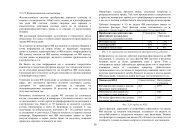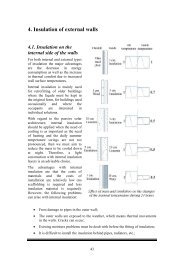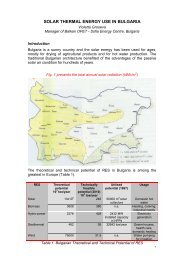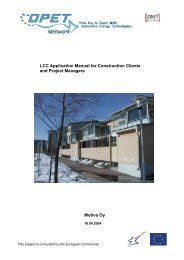Guidebook for Energy Efficiency in Municipalities
Guidebook for Energy Efficiency in Municipalities
Guidebook for Energy Efficiency in Municipalities
You also want an ePaper? Increase the reach of your titles
YUMPU automatically turns print PDFs into web optimized ePapers that Google loves.
While heat<strong>in</strong>g and cool<strong>in</strong>g might comprise up to two-thirds of energy consumption <strong>in</strong> an<br />
office, equipment used or controlled by occupants is responsible <strong>for</strong> the rest. This<br />
<strong>in</strong>cludes light<strong>in</strong>g, computers and other office equipment, boil<strong>in</strong>g water units, etc. In some<br />
build<strong>in</strong>gs, occupants also control heat<strong>in</strong>g and cool<strong>in</strong>g systems.<br />
Office energy use can lead to annual energy costs of up to €20 per square metre and<br />
between 50 and 500 kilograms of GHG emissions per year. As a build<strong>in</strong>g occupant a<br />
municipality can play an important role <strong>in</strong> sav<strong>in</strong>g energy, <strong>in</strong>clud<strong>in</strong>g:<br />
alert<strong>in</strong>g build<strong>in</strong>g managers to problems and faults;<br />
switch<strong>in</strong>g off lights and equipment that are not needed;<br />
seek<strong>in</strong>g tra<strong>in</strong><strong>in</strong>g <strong>in</strong> energy efficiency issues relevant to the energy manager’s work.<br />
Activity<br />
Us<strong>in</strong>g office equipment<br />
Us<strong>in</strong>g lights and air-condition<strong>in</strong>g<br />
Us<strong>in</strong>g kitchen and coffee/tea-mak<strong>in</strong>g facilities<br />
Relevant <strong>in</strong><strong>for</strong>mation sheets<br />
T5. Office equipment<br />
T1. Heat<strong>in</strong>g and cool<strong>in</strong>g of build<strong>in</strong>gs, T3. Light<strong>in</strong>g<br />
T5. Office equipment, T7. Refrigeration<br />
F<strong>in</strong>ancial management<br />
F<strong>in</strong>ancial management creates a framework with<strong>in</strong> which all municipal operations are<br />
carried out. The budget priorities set, the purchas<strong>in</strong>g guidel<strong>in</strong>es established, the costbenefit<br />
criteria applied, and the contractual arrangements negotiated, all <strong>in</strong>fluence the<br />
k<strong>in</strong>ds of build<strong>in</strong>gs and equipment selected, and the behaviour of staff and contractors.<br />
A particular challenge <strong>for</strong> f<strong>in</strong>ancial management groups is the development of practical<br />
and effective mechanisms to facilitate <strong>in</strong>creased up-front <strong>in</strong>vestment costs where future<br />
sav<strong>in</strong>gs are <strong>in</strong>creased. Most municipalities treat <strong>in</strong>vestment funds separately from<br />
recurrent funds, which mean that they fail to implement many cost-effective energy<br />
efficiency measures.<br />
Activity<br />
Prepar<strong>in</strong>g and supervis<strong>in</strong>g purchas<strong>in</strong>g guidel<strong>in</strong>es<br />
Prepar<strong>in</strong>g and supervis<strong>in</strong>g leases, contracts, etc.<br />
Develop<strong>in</strong>g and implement<strong>in</strong>g f<strong>in</strong>ancial policy<br />
Relevant <strong>in</strong><strong>for</strong>mation sheets<br />
O3. Purchas<strong>in</strong>g policies<br />
O4. Leases and service contracts<br />
O5. Work<strong>in</strong>g with contractors<br />
O2. Monitor<strong>in</strong>g and report<strong>in</strong>g<br />
P3. F<strong>in</strong>ancial evaluation of projects<br />
Corporate support<br />
Much of the corporate support function is office-based, so direct energy use by this area<br />
of activity is typical of that of many offices. Some corporate support activities may be fairly<br />
energy <strong>in</strong>tensive, <strong>for</strong> example cater<strong>in</strong>g/hospitality often requires very energy <strong>in</strong>tensive<br />
commercial cater<strong>in</strong>g equipment, and the equipment used to provide coffee and tea at<br />
meet<strong>in</strong>gs often consumes surpris<strong>in</strong>gly large amounts of energy. Special events can also<br />
use large amounts of energy, depend<strong>in</strong>g on the venues and types of activities chosen.<br />
Events provide an opportunity <strong>for</strong> a municipality to make a strong public statement about<br />
global warm<strong>in</strong>g, while <strong>in</strong>vestments <strong>in</strong> actions that normally would not be considered costeffective<br />
can be justified on educational or promotional grounds. For example, human<br />
resources groups can <strong>in</strong>clude per<strong>for</strong>mance on energy efficiency job descriptions, and<br />
per<strong>for</strong>mance <strong>in</strong>dicators that work aga<strong>in</strong>st energy efficiency improvement can be modified<br />
(e.g., if a staff member’s per<strong>for</strong>mance contract is based on the number of permits<br />
approved, this may discourage thorough scrut<strong>in</strong>y of the energy aspects of applications).<br />
Activity<br />
Cater<strong>in</strong>g/hospitality<br />
Relevant <strong>in</strong><strong>for</strong>mation sheets<br />
O3. Purchas<strong>in</strong>g policies, O4. Leases and contracts<br />
T7. Refrigeration, T4. Hot water production






